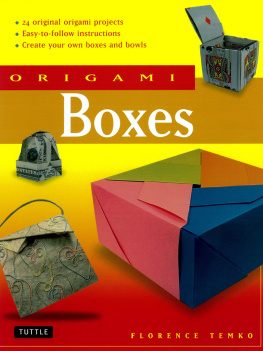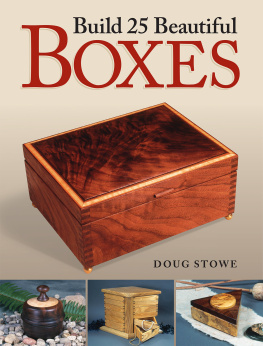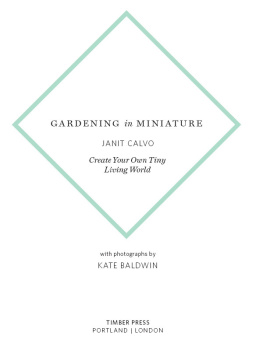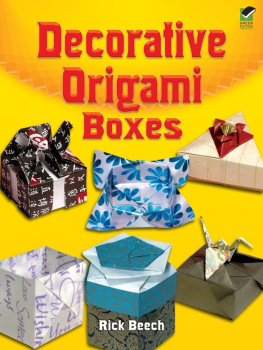
Little Bead Boxes
JULIA S. PRETL

12 Miniature Boxes Built with Beads


2006 Creative Publishing international, Inc.
Text and illustrations 2006 Julia S. Pretl

Creative Publishing international, Inc.
18705 Lake Drive East
Chanhassen, Minnesota 55317
1-800-328-3895
www.creativepub.com Photographer: Allan Penn
Cover & Book Design: Deborah Fillion
Illustrations: Julia S. Pretl Digital edition: 978-1-61673-319-3
Softcover edition: 978-1-58923-291-4
Library of Congress Cataloging-in-Publication Data Pretl, Julia S.
Little bead boxes : 12 miniature boxes built with beads / Julia S. Pretl.
p. Beadwork. 2. 2.
Ornamental boxes. 3. Miniature craft. I. Title.
TT860.P74 2006
745.582dc22 2006010449
CIP ISBN-13: 978-1-58923-291-4 (pbk)
ISBN-10: 1-58923-291-7 (pbk) Printed in Singapore
10 9 8 7 6 5 4 3 2 Due to differing conditions, materials, and skill levels, the publisher and various manufacturers disclaim any liability for unsatisfactory results or injury due to improper use of tools, materials, or information in this publication. All rights reserved.
No part of this work covered by the copyrights hereon may be reproduced or used in any form or by any meansgraphic, electronic, or mechanical, including photocopying, recording, taping of information on storage and retrieval systemswithout the written permission of the publisher.  This book is dedicated to the box beaders, who applauded me for the fun parts, yelled at me for the difficult parts, and made many suggestions to help me improve my instructions. I thank you all. This book is the result of many hours spent designing, redesigning, teachingand making boxes, boxes, and more boxes. With nearly every box I make, I discover a slightly easier way to accomplish one part or another. I made my first beaded box in 1992. I had grown tired of making amulet purses, and I was looking for a bigger project.
This book is dedicated to the box beaders, who applauded me for the fun parts, yelled at me for the difficult parts, and made many suggestions to help me improve my instructions. I thank you all. This book is the result of many hours spent designing, redesigning, teachingand making boxes, boxes, and more boxes. With nearly every box I make, I discover a slightly easier way to accomplish one part or another. I made my first beaded box in 1992. I had grown tired of making amulet purses, and I was looking for a bigger project.
I remembered one particular amulet bag in which I had decreased the corners so that the bottom was relatively flatand I decided to expand on this idea. My end product was a triangular purse about 4 (11.4 cm) high with a lid and a braided strap. I discovered later that I could also make a triangular purse in square stitch and a square purse, too. Years later, I was asked to teach a class on my beaded purses. Because I felt that it was important to offer several different options to my students, I set out to find a formula for beading five- and six-sided purses. I experimented by making 2 (5.1 cm) models of each shape, and, as I worked, I found that by increasing the tension of my thread and reducing the size, I had created a wonderful, tiny box! Inspired, I beaded a lid for my little box and then embellished it by adding a handle and feet made from lampworked beads.
Thanks to the encouragement of my friends at home and the incredible beading community that has come together on the Web, I gathered the courage to write this book. I hope that you enjoy creating these little treasures as much as I do!
Contents






Getting Started

My little boxes are self-supporting, peyote-stitched vessels, woven with cylinder beads. I developed this technique by applying to beadwork the same principles that are used to increase in crochet. These boxes may be as small as 1 (2.5 cm) wideor as large as your patience (and tension) will allow. The process of making a box has many steps. As you complete each step, write down what you have done in case you need to refer back later in the project.
Before you begin a new step, read through that section carefully. There are several instances in which the instructions differ for different types of boxes. There may also be important or helpful notes to help you work. Study the diagrams carefully, and make sure that your beadwork structure conforms to the diagram before you proceed to the next row. There are patterns and instructions for twelve boxes, three of each of the four shapes: triangle, hexagon, pentagon, and square. There are also instructions for two oblong variations.
The patterns and instruction sections have been arranged from the easiest box to build (triangle) to the more complex (square), but you may begin with any of the four box shapes. Whichever you choose, you will begin making each box at the center of the base.
Tools and Materials
To make bead boxes, youll need the following materials and supplies. Each project in the book has its own materials list, which will give you the number and size of the beads for that project. Each box is made with multiple colors (coded in the instructions as color A, B, C, D, and so on).

Size 11 cylinder beads (I use Miyuki Delicas)

Size 12 or smaller beading needles

Bead thread (such as Silamide or GSP fishing line)

Large, decorative beads (for the feet and finials)

Size 11 round seed beads

Needle-nose pliers When I first began teaching, I strongly encouraged my students to work with Silamide, a bonded nylon thread, and I used it for every box I made.

Size 11 cylinder beads (I use Miyuki Delicas)

Size 12 or smaller beading needles

Bead thread (such as Silamide or GSP fishing line)
 Next page
Next page






 12 Miniature Boxes Built with Beads
12 Miniature Boxes Built with Beads 
 2006 Creative Publishing international, Inc.
2006 Creative Publishing international, Inc. Creative Publishing international, Inc.
Creative Publishing international, Inc. This book is dedicated to the box beaders, who applauded me for the fun parts, yelled at me for the difficult parts, and made many suggestions to help me improve my instructions. I thank you all. This book is the result of many hours spent designing, redesigning, teachingand making boxes, boxes, and more boxes. With nearly every box I make, I discover a slightly easier way to accomplish one part or another. I made my first beaded box in 1992. I had grown tired of making amulet purses, and I was looking for a bigger project.
This book is dedicated to the box beaders, who applauded me for the fun parts, yelled at me for the difficult parts, and made many suggestions to help me improve my instructions. I thank you all. This book is the result of many hours spent designing, redesigning, teachingand making boxes, boxes, and more boxes. With nearly every box I make, I discover a slightly easier way to accomplish one part or another. I made my first beaded box in 1992. I had grown tired of making amulet purses, and I was looking for a bigger project.





 My little boxes are self-supporting, peyote-stitched vessels, woven with cylinder beads. I developed this technique by applying to beadwork the same principles that are used to increase in crochet. These boxes may be as small as 1 (2.5 cm) wideor as large as your patience (and tension) will allow. The process of making a box has many steps. As you complete each step, write down what you have done in case you need to refer back later in the project.
My little boxes are self-supporting, peyote-stitched vessels, woven with cylinder beads. I developed this technique by applying to beadwork the same principles that are used to increase in crochet. These boxes may be as small as 1 (2.5 cm) wideor as large as your patience (and tension) will allow. The process of making a box has many steps. As you complete each step, write down what you have done in case you need to refer back later in the project.  Size 11 cylinder beads (I use Miyuki Delicas)
Size 11 cylinder beads (I use Miyuki Delicas)